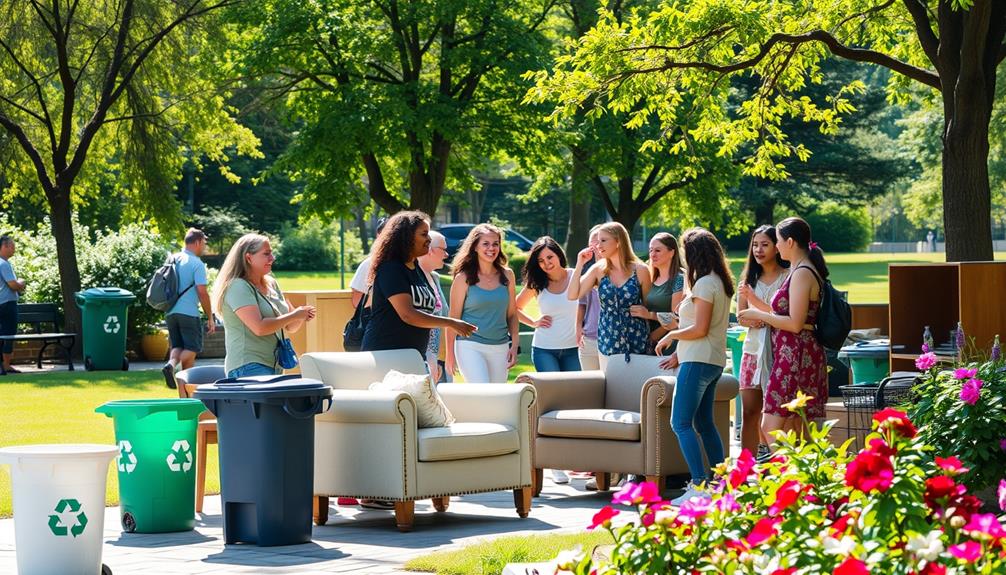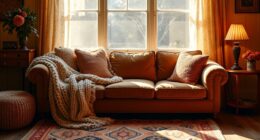You have the option to easily dispose of unwanted furniture at no cost by donating it to local charities that provide pickup services. Organizations such as Salvation Army and Habitat for Humanity can come to your house to pick up your gently used items. This not only helps you declutter but also assists families in need and helps reduce waste in landfills. If you have a large amount of furniture, you may want to reach out to specific charities to make special arrangements. You could also consider using platforms like Freecycle or Facebook Marketplace for giveaways. There are many options available to help facilitate this process and benefit everyone involved.
Key Takeaways
- Contact local charities like Salvation Army and Habitat for Humanity for free furniture pickup services.
- Use online platforms like Freecycle or Facebook Marketplace to give away furniture for free.
- Schedule a free pickup with Goodwill, but confirm their specific policies at your location.
- Utilize curbside pickups during bulk waste collection days in your municipality for responsible disposal.
- Consider donating to Houston Furniture Bank for a $65 fee, which includes pickup for up to four pieces.
Donation Options for Furniture
When you're ready to part with your furniture, donation options can make the process simple and rewarding. Many local charities, such as the Salvation Army and Habitat for Humanity, offer free pickup services for gently used furniture donations, allowing you to donate directly from home.
This not only helps those in need but also contributes to a more sustainable environment, as reusing furniture reduces waste. If you're in the Houston area, consider the Houston Furniture Bank, which charges a standard fee of $65 for pickup of up to four pieces. This guarantees your items reach families in need, providing them with essential furnishings. Additionally, donating your furniture can be an opportunity to declutter your home while supporting a good cause. It’s also important to consider *pricing used furniture effectively* if you choose to sell items instead, ensuring that pieces are fairly priced based on condition and quality. By making smart choices with furniture disposal or resale, you promote both social welfare and environmental accountability.
Before donating, check that your furniture is in good condition, as most charities prefer items that are functional and usable.
Emotional and psychological growth is often supported by creating a comfortable home environment. Goodwill also accepts furniture donations, but make sure to confirm their policies with your local store, as they can vary.
Local Charity Pickup Services

If you're looking to donate your furniture without the hassle of transportation, many local charities provide convenient pickup services. Organizations like Goodwill and the Salvation Army offer free furniture pickup, allowing you to easily donate gently used items.
In the Houston area, Habitat for Humanity's ReStore also accepts furniture donations and can schedule pickups to support their mission of providing affordable housing. Utilizing these charity services can also be a great way to practice effective budgeting by decluttering your home and potentially saving on disposal costs.
The Houston Furniture Bank offers furniture pickup services for a standard fee of $65 for up to four pieces. If you have larger donations, you can reach out to them via call or email for arrangements.
Before scheduling a pickup, make sure your items are in good condition by checking the charity's guidelines. Most local nonprofits prefer items that are gently used, as they aim to support low-income families and contribute to community welfare.
Utilizing these charity pickup services not only helps you declutter your home for free but also plays an essential role in assisting those in need.
Eco-Friendly Disposal Methods

Eco-friendly disposal methods are essential for reducing waste and preserving our planet. One effective way to dispose of unwanted furniture is by considering donation pickup services from local charities like Goodwill or Habitat for Humanity. They often provide free pickup, allowing you to declutter while supporting those in need and minimizing landfill waste.
Additionally, some hotels and resorts, especially those that offer family-friendly amenities, might partner with local charities to facilitate furniture donations, further promoting community support and sustainability family-friendly amenities.
Additionally, explore recycling programs in your area that accept furniture. Many municipalities have initiatives to recycle and repurpose old items, promoting sustainability in your community.
You can also utilize online platforms like Freecycle or Facebook Marketplace to give away your furniture for free, facilitating reuse and preventing unnecessary waste.
If you prefer a more structured approach, schedule a curbside pickup with your local waste management service. Some municipalities offer bulk waste collection days specifically for large items, ensuring responsible disposal.
Finally, check for community events or organizations that host bulk waste collection drives. These events not only help you get rid of your furniture but also support local environmental efforts.
Scheduling Furniture Removal

Scheduling furniture removal can be a straightforward process if you know where to start. First, consider reaching out to local charities like the Houston Furniture Bank. They offer a pickup service for a standard fee of $65 for up to four pieces, with a quick turnaround time of 48-72 hours.
If you have more than 15 pieces, it's best to call (713) 232-9665 or email service@houstonfurniturebank.org for a specialized pickup.
Another option is Fire Dawgs, which provides free in-person estimates for junk removal services. You can easily schedule a time for their two-person crew to assess your items.
For convenience, the Houston Furniture Bank has a pickup text line at (713) 396-0180, making it simple to arrange a pickup or ask any questions about the donation process.
Keep in mind that many local charities require confirmation of acceptance before drop-off. Consequently, it's vital to check their guidelines and schedule pickups in advance to guarantee they'll accept your furniture.
Benefits of Donating Furniture

Donating furniture not only declutters your space but also makes a meaningful impact in your community. When you choose to donate, you're helping families in need who rely on charitable donations to furnish their homes. Many low-income households face financial limitations, and your gently used furniture can greatly improve their living conditions.
Moreover, donating furniture contributes to reducing landfill waste, as many charities focus on repurposing and recycling items. This promotes environmental responsibility and sustainability. Plus, you might qualify for tax deductions, making it a win-win situation.
Here's a quick overview of the benefits of donating furniture:
| Benefits | Description |
|---|---|
| Community Impact | Supports local organizations and enhances living conditions. |
| Support for Families | Provides essential furniture for families in need. |
| Environmental Benefits | Reduces landfill waste and promotes recycling. |
| Tax Deductions | Potential financial benefits through tax deductions. |
Frequently Asked Questions
How Do I Get Rid of a Bunch of Furniture?
To get rid of a bunch of furniture, you can donate it, post on social media for free pickup, or arrange a neighborhood swap. Consider local services or community events to help you clear out items efficiently. Additionally, you might even consider repurposing some pieces for a fresh look if you’re not quite ready to part with them. For example, learning how to paint without sanding can make transforming furniture much easier and quicker, saving time while still achieving a professional finish. This could be a great option for giving old items new life before deciding to discard them.
How Do I Get Rid of My Sofa for Free?
To get rid of your sofa for free, consider donating it to local charities, using online platforms like Freecycle, or placing it curbside with a "free" sign. Community groups can also help find a new home.
Who Is Best to Donate Furniture To?
When you're ready to part with your furniture, think of charities like the Houston Furniture Bank or Goodwill. They're like bridges, connecting your gently-used items to families in need. Your donation can change lives!
Does Goodwill Pick up Furniture for Free Near Me?
Goodwill doesn't always pick up furniture for free near you. Pickup fees vary by location, so check with your local store. Verify your items meet their acceptance criteria before scheduling a pickup.
Conclusion
As you watch your old furniture leave your doorstep, imagine the smiles on the faces of those in need. By donating, you're not just clearing space; you're breathing new life into someone else's home. Picture your once-loved chair cradling a child, or your sturdy table hosting family dinners. Embrace the joy of giving, knowing that your unwanted items are transforming lives while keeping our planet green. You're making a difference, one piece of furniture at a time.









